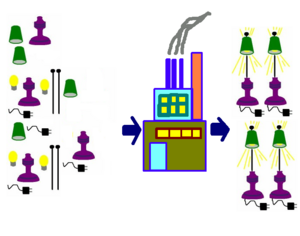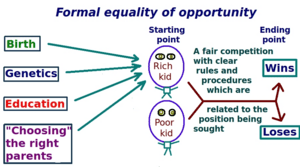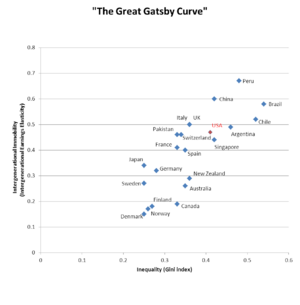Equal opportunity facts for kids
Equal opportunity means that everyone should be treated fairly. It means people should have the same chances to succeed, without unfair obstacles like prejudice or special favors. For example, in a job, the most skilled person should get the position. It shouldn't matter where they were born, how much money their family has, their religion, gender, race, or if they have a disability.
The main idea is that your success should depend on your own hard work and skills, not on things you can't control, like having rich or famous relatives. This concept is important in areas like getting a job or going to school. It's a key part of what's called a meritocracy, where people are rewarded based on their abilities.
Contents
What People Think About Equal Opportunity

People have different ideas about what "equal opportunity" truly means. It's a topic discussed in many fields, like how societies work and how people think. It's not just about jobs anymore; it also applies to things like getting a loan, finding a home, or getting into college.
In its simplest form, equal opportunity is like saying everyone should be treated equally under the law. It's also linked to the idea that the best person for the job or task should get it, based on their skills.
The terms "equality of opportunity" and "equal opportunity" are often used to mean the same thing. "Equal opportunity" is often used to describe rules or laws, especially in jobs, to make sure everyone has a fair chance. This idea has become very popular in Western countries over the last few centuries. It's connected to the idea of social mobility, which means people can move up in society, often from humble beginnings to great success.
How Equal Opportunity Works
Understanding the Idea
Imagine society has different jobs and roles, some more desired than others. Equal opportunity tries to make the process of getting these roles fair. This applies to jobs in companies, clubs, charities, and universities.
Some people believe that equal opportunity can exist in different types of governments, like democracies or even communist countries. However, it's mostly linked to countries with competitive markets and strong laws that protect fairness.
People with different political views see equal opportunity differently. For example, some believe that everyone should start with the same conditions. Others, who value tradition, might see some inequality as natural.
The idea of equal opportunity has grown to cover many areas beyond just minority rights. It now includes how companies find, hire, train, promote, and even fire employees. It also covers things like wages, sick leave, and retirement benefits.
This concept applies to many parts of public life. This includes how easy it is to vote, medical care, and whether boys and girls have the same chances to do things like travel in space. It also covers things like how models are chosen in fashion shows or who gets into universities.
Equal opportunity focuses on a person's own hard work, talent, and skills. It doesn't focus on their social class, race, or family background. It's seen as unfair if outside factors, which a person can't control, greatly affect their life. So, equal opportunity is about having a fair process, while equality of outcome is about everyone ending up with the same results. In general, equal opportunity is thought to help society by allowing more people to succeed.
Different Kinds of Equal Opportunity
There are a few ways to think about equal opportunity.
Formal Equal Opportunity
Formal equal opportunity is about making sure there's no direct, unfair discrimination. It means that any choices made must be fair and based on a person's skills. For example, a job interview should only judge applicants on their ability to do the job. A university shouldn't accept a less capable student just because they can pay more.
This type of equal opportunity is like a basic standard. It focuses on:
- Openings for Everyone: Important jobs should be open to all. Job openings should be advertised so everyone has a chance to apply.
- Fair Judging: Applications should be judged based on who is best qualified. For example, a choir director should be chosen for their musical knowledge, not their hair color.
- Choosing the Best: The most qualified person gets the job. Even though the result is unequal (one person gets the job, the other doesn't), the process is seen as fair.
This "formal" approach is a simple way to think about equal opportunity. It mainly applies to public life, not private things like family or religion. What's fair and unfair is decided beforehand.
Economists Milton and Rose Friedman explained this idea. They said that equal opportunity doesn't mean everyone is born exactly the same. Some children are born blind, others can see. But it means there should be "no unfair barriers" stopping someone from reaching their goals. Things like birth, nationality, race, religion, or gender should not decide a person's opportunities. Only their abilities should matter.
Substantive Equal Opportunity
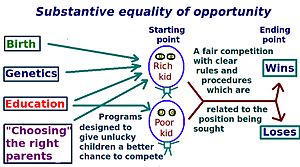
Substantive equal opportunity is a broader idea. It looks at indirect discrimination. It's more complex and harder to achieve, especially in societies where there's a big difference in wealth.
This approach believes that people don't all start from the same place. Some have had different experiences before they even begin to compete. If people don't have equal skills or talents, this approach suggests that governments or other groups should help make applicants more equal before they compete. This might mean providing better education or resources to those who started with disadvantages.
For example, children from wealthy families often have a big advantage over other children. Their parents can pass on wealth and good education, making it harder for others to climb the social ladder. Substantive equal opportunity tries to fix these "before-the-start" issues. However, once the competition begins, the most qualified person should still be chosen.
This idea is also called luck egalitarianism. It means that if unequal results happen because of bad luck, it's unfair. But if they happen because of a person's choices, it's fair. The main goal is to give children from less fortunate backgrounds a better chance to succeed.
Sometimes, this means using affirmative action policies. These policies help disadvantaged groups catch up after a long time of discrimination. This might involve the government transferring resources to help those groups. For example, in São Paulo, Brazil, a rule was made for fashion shows to have at least 10% black or indigenous models. This was to fight a bias towards white models.
The substantive approach also believes that things like personal beauty, sometimes called "lookism", shouldn't affect hiring decisions. It argues that judging people by their looks instead of their skills is unfair, just like judging them by their race or gender.
Meritocracy
Meritocracy is a system where people are rewarded based on their individual skills, intelligence, education, or other qualities that show their merit. Equal opportunity is a big part of a meritocracy. Some people see equal opportunity as focusing on what happens before a competition, while meritocracy focuses on fairness during the competition itself.
Why Equal Opportunity Matters
Most people agree that equal opportunity is good for society. When it's missing, it can hurt a country's economic growth. For example, some reports suggest that countries in the Middle East have struggled economically partly because they lack equal opportunity.
Challenges in Making it Happen
It's generally agreed that making equal opportunity happen can be difficult. Even simple rules can have unexpected problems.
For example, if a government wants to provide equal healthcare for everyone, it can be very expensive. Or, if men's and women's bathrooms are built the same size for fairness, it might still be unfair because men's urinals take up less space, meaning women often have to wait longer. A fairer solution might be to give women's restrooms more space.
It's also hard to bring substantive equal opportunity to every job or industry. If a country focuses on helping people succeed in one area, people with other skills might be left out.
Many countries have special groups that work on equal opportunity issues. For example, in the United States, there's the Equal Employment Opportunity Commission. These groups try to make sure everyone has a fair chance.
Measuring Equal Opportunity
It's hard to measure equal opportunity, whether you're looking at one job decision or at groups of people over time.
- Single Case: You can check if fair procedures were followed for a specific job. Was the best person chosen? This is a judgment call, and people's biases can make it hard.
- Groups: For larger groups, like a company or an entire country, people use statistical analysis. They look at patterns to see if certain groups are being unfairly treated. For example, a university might track how many women apply for professor jobs versus how many get them.
It's difficult to prove unfair treatment, even with statistics. Different people can interpret the same numbers differently. However, these analyses can show where problems might exist. For example, a study in Italy looked at professors' last names and found that many professors had similar last names, suggesting nepotism (favoring family members) was happening.
Sometimes, equal opportunity is measured by looking at the results, like average salaries for different groups. If one group consistently earns less, it might suggest unequal opportunity.
Equal Opportunity in Business
Equal opportunity is a basic idea in business. Many economists believe that fair markets will naturally reduce discrimination. Companies that hire based on skills, not unfair reasons, tend to do better than those that don't.
Companies often state they are "equal opportunity employers" in job ads. This means they welcome applicants from all backgrounds. The goal of equal opportunity is often easier to achieve when the economy is growing, creating more chances for people to move up. Research also shows that equal opportunity is linked to better health outcomes for people.
A Brief History
Over time, societies have slowly moved towards respecting equal opportunity more. In the past, many people were peasants or slaves, controlled by a ruling class. But over the last thousand years, old systems like feudalism (where land was owned by lords and worked by peasants) broke down. New ideas about citizenship and individual rights emerged. Kings were replaced by parliaments, and Slavery was generally abolished.
In the United States, the Fourteenth Amendment was a big step. It said everyone should have "equal protection under the law." This led to later laws and court decisions that fought for equal opportunity, especially for African Americans and women.
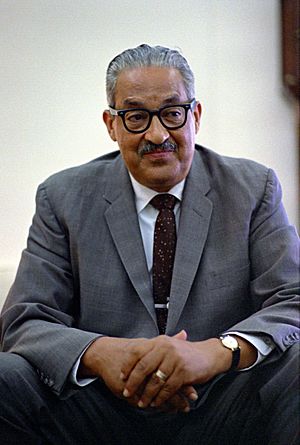
In 1961, President John F. Kennedy created a committee on equal opportunity. Later, the Civil Rights Act of 1964 made equal opportunity in jobs a legal requirement. Businesses had to follow rules for fair hiring and promotions. The Equal Employment Opportunity Commission was set up to handle complaints about discrimination.
Laws like the Americans with Disabilities Act of 1990 (1990) also made it illegal to discriminate against people with disabilities. In 2008, the Genetic Information Nondiscrimination Act stopped employers from using genetic information when hiring or promoting.
What Some People Say Against It
Some people criticize the idea of equal opportunity. They say it's hard to define exactly what it means. It's also hard to measure, and putting it into practice can cause problems.
One criticism is that even if everyone starts fairly, inequalities might still happen. Some argue that trying to achieve equal opportunity too strictly might lead to other problems. For example, if wealthy people give a lot of money to political campaigns, it might lead to better laws. But if laws limit these donations to create equal opportunity for all political participants, it might make political decisions worse in the long run.
Economist Larry Summers believes we should focus on equal opportunity, not equal outcomes. He thinks improving public education is the best way to do this. However, others argue that equal opportunity and equal outcomes are connected. Wealthier people often have more opportunities because they can afford better schools, healthcare, and nutrition for their children.
Some conservative thinkers, like Dinesh D'Souza, argue that the government shouldn't try to enforce equal opportunity. He says that parents naturally try to give their children an "edge" in life, like teaching them chess or getting them into the best schools. He believes the government shouldn't try to stop this or force parents to raise other people's children.
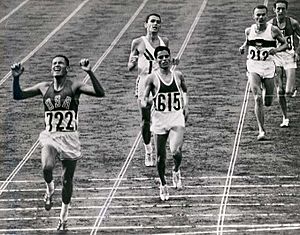
A similar argument was made by Robert Nozick. He said that to achieve equal opportunity, you either have to make things worse for those who are more fortunate or improve things for those who are less fortunate. He also argued that equal opportunity rules can violate a property owner's rights to run their business as they see fit.
Other critics say that luck plays a big role in success, and it's impossible to create a perfectly fair system. They argue that life isn't just one big race where everyone competes for a single prize.
See also
 In Spanish: Igualdad de oportunidades para niños
In Spanish: Igualdad de oportunidades para niños
- Affirmative action in the United States
- Civil liberties
- Egalitarianism
- Equal employment opportunity
- Free education
- Inclusion (education)
- Social inequality
- Substantive equality
- Universal access
- Universal access to education


